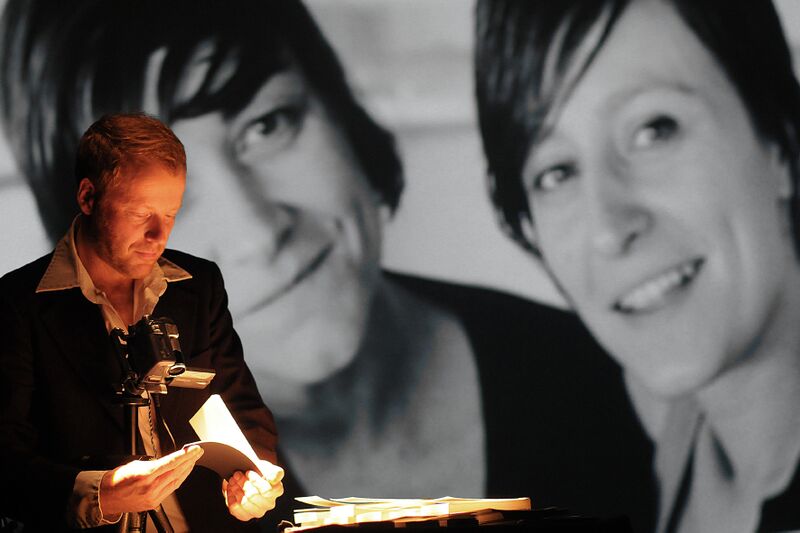Photographic flipbooks, sometimes called flicker-books. You know what I mean? Those little things you flick with your thumb, producing an instant mini animation? Volker Gerling makes them. He picks a subject, asks them to pose, takes 36 clickety-click shots in 12 seconds, then uses high-quality photographic paper to produce beautiful and unique artworks.
He shows us what it feels like to be one of his models by turning his camera on us. We, his audience, pose for a group photo, but as the 12 seconds – a long time! – unfolds, and we are amused and distracted by the loud shutter clicks, we dissolve a little, smile, blink, wipe our hair from our brow, glance at our neighbour. That’s what happens.
Gerling then tells us how he finds his subjects, and how he disseminates his work. At first he played it safe and went to the arty bars and cafes of hometown Berlin, picking subjects, and showing the small flipbooks, free to audience, but with donations gratefully accepted. Then he realised he needed to be braver, to go further afield, literally and metaphorically. Out into the small villages of Germany, and beyond, he went – and still goes. He’s walked over 3,500km so far.
What he does is walk with a tent on his back, and on his front a tray (a cigarette-girl or popcorn-seller style tray, attached to his shoulders). He carries no food or money. He makes friends. He invites people to view his exhibition of flipbooks. He also sometimes approaches people and asks them to be models for a new book. We hear stories about the people he has met: Alfred, who invites him into his house to show him the bed where his wife died, and who still has a wardrobe full of snazzy suits from his youth, offers Gerling a glass of Schnapps and some chocolate; a young boy called Alex who is swimming in the canal with his friends, chuffed that he has been singled out to be a model; a mother and daughter called Sofia and Francesca, who are more like friends, and who write small texts about each other for the artist.
This small but perfectly formed theatre show is so much more than a lecture-demonstration about the walks and the flipbooks. It is also an investigation of the very nature and processes of both photography and cinema. Gerling stands at a lectern with an overhead projector, and he slowly flips through a book, a simple portrait of one person. The slight flickers in her eyelids, the little smile at the corner of her mouth that comes and goes… it is beautiful, utterly beautiful. We meet a whole host of people who are subjects of flipbook portraits. A handsome Iranian man whose body is wasting away; three teenagers, a loving couple and their gooseberry friend who stares ahead embarrassed as her friends kiss; a family of four, the smallest child wiggling and the bigger one pulling faces. They have simple unemotive titles: Older Man with Tie, Man with Baseball Cap, Woman With Shawl etc. One flipbook called Two Boys Fishing has no movement, seemingly. Each book is flicked three times, and after the second showing of this one, Gerling says ‘look at the grass by the boy on the right’s shoulder” and yes –it’s moving in the wind. He quotes St Paul: ‘What we see comes from what we do not see.’
Our artist is mostly interested in people, but he has also branched out to do time-lapse flipbooks of apartment blocks (one shot every 2o minutes throughout the night), the moon moving across a night sky behind a cathedral, and an extraordinary ‘film’ of a candle in a cafe burning down over 7 hours.
Because, yes – these are films, this is cinema. Flipbook cinema, but cinema. Portraits in motion, in fact. Seeing the images on a big screen, we believe we are seeing moving image. Because we are. The filming process is no different – it is just that the gap between frames is smaller. Gerling celebrates the gaps, and exploits the play with time offered by his process, flicking through the books at different speeds to produce different effects.
A truly charming and thought-provoking show that gets to the core of what it means to capture an image; and that also adds a beautiful example to the growing body of work created by artists for whom walking is at the heart of their practice.
Portraits in Motion is presented at Summerhall by Aurora Nova.

